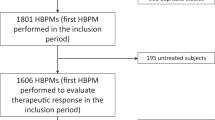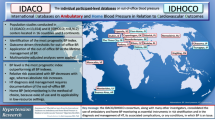Abstract
In a 12-week, randomized, controlled trial, we investigated whether home blood pressure monitoring (HBPM) would improve treatment adherence and blood pressure control in stage 2 and 3 hypertension. Eligible patients (18–75 years of age and 160–199/100–119 mmHg of clinic systolic/diastolic blood pressure after a 1-week wash-out) were randomized in a 1:4 ratio to an experimental group (with HBPM) and a control group (without HBPM). All patients started antihypertensive treatment with the irbesartan 150 mg/hydrochlorothiazide 12.5 mg/day combination, with the possible addition of irbesartan 150 mg/day and uptitration to irbesartan 300 mg/hydrochlorothiazide 25 mg/day at 4 and 8 weeks of follow-up, respectively. The primary endpoint was the clinic blood pressure control (systolic/diastolic, nondiabetes <140/90 mmHg and diabetes <130/80 mmHg) rate at 12 weeks of follow-up. The randomized patients in the HBPM (n = 96) and control groups (n = 405) had similar characteristics at baseline and similar use of higher dosages of irbesartan/hydrochlorothiazide (300 mg/12.5–25 mg) at 4 (9.4% vs. 12.2%, P = 0.45) and 8 weeks of follow-up (27.1% vs. 35.5%, P = 0.13). During follow-up, both the cumulative treatment discontinuation rate (1.0% vs. 12.6%, P = 0.0008) and the less optimal treatment adherence rate (<90% of prescribed medication, 1.0% vs. 9.9%, P = 0.005) were significantly lower in the HBPM group than in the control group. The proportion of patients who achieved the goal of clinic blood pressure control at 12 weeks of follow-up was significantly higher in the HBPM group than in the control group (66.7% vs. 55.1%, P = 0.04). In conclusion, HBPM improved treatment adherence and blood pressure control in patients with hypertension, despite similar antihypertensive treatment intensities.
This is a preview of subscription content, access via your institution
Access options
Subscribe to this journal
Receive 12 print issues and online access
$259.00 per year
only $21.58 per issue
Buy this article
- Purchase on Springer Link
- Instant access to full article PDF
Prices may be subject to local taxes which are calculated during checkout



Similar content being viewed by others
References
Kario K, Shimbo D, Hoshide S, Wang JG, Asayama K, Ohkubo T, et al. Emergence of home blood pressure-guided management of hypertension based on global evidence. Hypertension. 2019;74:229–36.
Stergiou GS, Kario K, Kollias A, McManus RJ, Ohkubo T, Parati G, et al. Home blood pressure monitoring in the 21st century. J Clin Hypertens (Greenwich). 2018;20:1116–621.
Wang JG, Bu PL, Chen LY, Chen X, Chen YY. Chinese Hypertension League (CHL) Guideline Committee for Home Blood Pressure Monitoring et al. 2019 Chinese Hypertension League guidelines on home blood pressure monitoring. J Clin Hypertens. 2020;22:378–83.
Fletcher BR, Hartmann-Boyce J, Hinton L, McManus RJ. The effect of self-monitoring of blood pressure on medication adherence and lifestyle factors: a systematic review and meta-analysis. Am J Hypertens. 2015;28:1209–21.
Tucker KL, Sheppard JP, Stevens R, Bosworth HB, Bove A, Bray EP, et al. Self-monitoring of blood pressure in hypertension: a systematic review and individual patient data meta-analysis. PLoS Med. 2017;14:e1002389.
Cappuccio FP, Kerry SM, Forbes L, Donald A. Blood pressure control by home monitoring: meta-analysis of randomised trials. BMJ. 2004;329:145.
Ogedegbe G, Schoenthaler A. A systematic review of the effects of home blood pressure monitoring on medication adherence. J Clin Hypertens. 2006;8:174–80.
Agarwal R, Bills JE, Hecht TJ, Light RP. Role of home blood pressure monitoring in overcoming therapeutic inertia and improving hypertension control: a systematic review and meta-analysis. Hypertension. 2011;57:29–38.
Huang QF, Sheng CS, Li Y, Ma GS, Dai QY, Wang JG. Efficacy and safety of a fixed combination of irbesartan/hydrochlorothiazide in Chinese patients with moderate to severe hypertension. Drugs R D. 2013;13:109–17.
Lee JY, Kusek JW, Greene PG, Bernhard S, Norris K, Smith D, et al. Assessing medication adherence by pill count and electronic monitoring in the African American study of kidney disease and hypertension (AASK) pilot study. Am J Hypertens. 1996;9:719–25.
Asmar R, Khabouth J, Topouchian J, El Feghali R, Mattar J. Validation of three automatic devices for self-measurement of blood pressure according to the International Protocol: the Omron M3 Intellisense (HEM-7051-E), the Omron M2 Compact (HEM 7102-E), and the Omron R3-I Plus (HEM 6022-E). Blood Press Monit. 2010;15:49–54.
Coleman A, Steel S, Freeman P, de Greeff A, Shennan A. Validation of the Omron M7 (HEM-780-E) oscillometric blood pressure monitoring device according to the British Hypertension Society protocol. Blood Press Monit. 2008;13:49–54.
Halme L, Vesalainen R, Kaaja M, Kantola I, Home Measurement of blood pressure study group. Self-monitoring of blood pressure promotes achievement of blood pressure target in primary health care. Am J Hypertens. 2005;18:1415–20.
Márquez-Contreras E, Martell-Claros N, Gil-Guillén V, de la Figuera-Von Wichmann M, Casado-Martínez JJ.Compliance Group of the Spanish Society of Hypertension (SEE) et al. Efficacy of a home blood pressure monitoring programme on therapeutic compliance in hypertension: the EAPACUM-HTA study. J Hypertens.2006;24:169–75.
Hosseininasab M, Jahangard-Rafsanjani Z, Mohagheghi A, Sarayani A, Rashidian A, Javadi M, et al. Self-monitoring of blood pressure for improving adherence to antihypertensive medicines and blood pressure control: a randomized controlled trial. Am J Hypertens. 2014;27:1339–45.
McManus RJ, Mant J, Bray EP, Holder R, Jones MI, Greenfield S, et al. Telemonitoring and self-management in the control of hypertension (TASMINH2): a randomised controlled trial. Lancet. 2010;376:163–72.
McKinstry B, Hanley J, Wild S, Pagliari C, Paterson M, Lewis S, et al. Telemonitoring based service redesign for the management of uncontrolled hypertension: multicentre randomised controlled trial. BMJ. 2013;346:f3030.
Margolis KL, Asche SE, Bergdall AR, Dehmer SP, Groen SE, Kadrmas HM, et al. Effect of home blood pressure telemonitoring and pharmacist management on blood pressure control: a cluster randomized clinical trial. JAMA. 2013;310:46–56.
Margolis KL, Asche SE, Dehmer SP, Bergdall AR, Green BB, Sperl-Hillen JM, et al. Long-term outcomes of the effects of home blood pressure telemonitoring and pharmacist management on blood pressure among adults with uncontrolled hypertension: follow-up of a cluster randomized clinical trial. JAMA Netw Open. 2018;1:e181617.
Fuchs SC, Ferreira-da-Silva AL, Moreira LB, Neyeloff JL, Fuchs FC, Gus M, et al. Efficacy of isolated home blood pressure monitoring for blood pressure control: randomized controlled trial with ambulatory blood pressure monitoring—MONITOR study. J Hypertens. 2012;30:75–80.
Verberk WJ, Kroon AA, Lenders JWM, Kessels AGH, van Montfrans GA, Smit AJ, et al. Self-measurement of blood pressure at home reduces the need for antihypertensive drugs: a randomized, controlled trial. Hypertension. 2007;50:1019–25.
Stergiou GS, Palatini P, Modesti PA, Asayama K, Asmar R, Bilo G, et al. Seasonal variation in blood pressure: evidence, consensus and recommendations for clinical practice. Consensus statement by the European Society of Hypertension Working Group on Blood Pressure Monitoring and Cardiovascular Variability. J Hypertens. 2020;38:1235–43.
Jo SH, Kim SA, Park KH, Kim HS, Han SJ, Park WJ. Self-blood pressure monitoring is associated with improved awareness, adherence, and attainment of target blood pressure goals: prospective observational study of 7751 patients. J Clin Hypertens. 2019;21:1298–304.
Neutel JM, Franklin SS, Lapuerta P, Bhaumik A, Ptaszynska A. A comparison of the efficacy and safety of irbesartan/HCTZ combination therapy with irbesartan and HCTZ monotherapy in the treatment of moderate hypertension. J Hum Hypertens. 2008;22:266–74.
Neutel JM, Franklin SS, Oparil S, Bhaumik A, Ptaszynska A, Lapuerta P. Efficacy and safety of irbesartan/HCTZ combination therapy as initial treatment for rapid control of severe hypertension. J Clin Hypertens (Greenwich). 2006;8:850–7.
Burnier M, Egan BM. Adherence in hypertension. Circ Res. 2019;124:1124–40.
Godwin M, Lam M, Birtwhistle R, Delva D, Seguin R, Casson I, et al. A primary care pragmatic cluster randomized trial of the use of home blood pressure monitoring on blood pressure levels in hypertensive patients with above target blood pressure. Fam Pract. 2010;27:135–42.
Parati G, Omboni S, Albini F, Piantoni L, Giuliano A, Revera M, et al. Home blood pressure telemonitoring improves hypertension control in general practice. The TeleBPCare study. J Hypertens. 2009;27:198–203.
Satoh M, Maeda T, Hoshide S, Ohkubo T. Is antihypertensive treatment based on home blood pressure recommended rather than that based on office blood pressure in adults with essential hypertension? (meta-analysis). Hypertens Res. 2019;42:807–16.
Acknowledgements
The authors gratefully acknowledge the participation of the patients and the contribution of the investigators from 18 participating hospitals. For detailed information on the participating hospitals, please refer to [9].
Funding
The study was funded and sponsored by Sanofi China (Shanghai).
Author information
Authors and Affiliations
Corresponding author
Ethics declarations
Conflict of interest
J-GW reports receiving consulting and lecture fees from Sanofi China (Shanghai). The other authors declare that they have no conflict of interest.
Additional information
Publisher’s note Springer Nature remains neutral with regard to jurisdictional claims in published maps and institutional affiliations.
Supplementary information
Rights and permissions
About this article
Cite this article
Zhang, D., Huang, QF., Li, Y. et al. A randomized controlled trial on home blood pressure monitoring and quality of care in stage 2 and 3 hypertension. Hypertens Res 44, 533–540 (2021). https://doi.org/10.1038/s41440-020-00602-0
Received:
Revised:
Accepted:
Published:
Issue Date:
DOI: https://doi.org/10.1038/s41440-020-00602-0
Keywords
This article is cited by
-
Role of home blood pressure monitoring in resistant hypertension
Clinical Hypertension (2023)
-
Seasonal variation in the effect of antihypertensive treatment with the irbesartan/hydrochlorothiazide combination
Hypertension Research (2023)
-
Hypertension in China: epidemiology and treatment initiatives
Nature Reviews Cardiology (2023)
-
Annual reports on hypertension research 2020
Hypertension Research (2022)
-
Update on Hypertension Research in 2021
Hypertension Research (2022)



